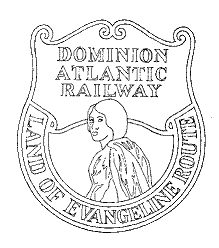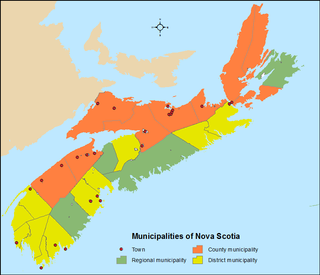
The Bay of Fundy is a bay between the Canadian provinces of New Brunswick and Nova Scotia, with a small portion touching the U.S. state of Maine. It is an arm of the Gulf of Maine. Its tidal range is the highest in the world. The name is probably a corruption of the French word fendu, meaning 'split'.

Annapolis County is a county in the Canadian province of Nova Scotia located in the western part of the province located on the Bay of Fundy. The county seat is Annapolis Royal.
Hammonds Plains is a suburban area of the Halifax Regional Municipality in Nova Scotia, Canada, located 20 km northwest of Downtown Halifax.

Digby is an incorporated town in southwestern Nova Scotia, Canada. It is in the historical county of Digby and a separate municipality from the Municipality of the District of Digby. The town is situated on the western shore of the Annapolis Basin near the entrance to the Digby Gut, which connects the basin to the Bay of Fundy.

Province House in Halifax is where the Nova Scotia legislative assembly, known officially as the Nova Scotia House of Assembly, has met every year since 1819, making it the longest serving legislative building in Canada. The building is Canada's oldest house of government. Standing three storeys tall, the structure is considered one of the finest examples of Palladian architecture in North America.

The Dominion Atlantic Railway was a historic railway which operated in the western part of Nova Scotia in Canada, primarily through an agricultural district known as the Annapolis Valley.

Annapolis Royal is a town in and the county seat of Annapolis County, Nova Scotia, Canada. The community, known as Port Royal before 1710, is recognised as having one of the longest histories in North America, preceding the settlements at Plymouth, Jamestown and Quebec. For nearly 150 years, it served as the capital of Acadia and subsequently Nova Scotia until the establishment of Halifax in 1749.

The Windsor and Hantsport Railway was a 56-mile (90.1 km) railway line in Nova Scotia between Windsor Junction and New Minas with a spur at Windsor which runs several miles east, serving two gypsum quarries located at Wentworth Creek and Mantua. It suspended operations in 2011.
Hantsport is an unincorporated area in the West Hants Regional Municipality, Nova Scotia, Canada. It is at the western boundary between West Hants Regional Municipality and Kings County, along the west bank of the Avon River's tidal estuary. The community is best known for its former industries, including shipbuilding, a pulp mill, as well a marine terminal that once loaded gypsum, mined near Windsor. The community is the resting place of Victoria Cross recipient William Hall.
The Tobeatic Wilderness Area is the largest protected area in the Canadian Maritimes, located in southwestern Nova Scotia. It contains nearly 120,000 hectares of land and spans parts of five counties, Annapolis, Digby, Queens, Shelburne and Yarmouth. Located adjacent to Kejimkujik National Park, it was formerly known as the Tobeatic Wildlife Management Area, and the Tobeatic Game Reserve.

Trunk 1 is part of the Canadian province of Nova Scotia's system of Trunk Highways.
Scouting in Nova Scotia has a long history, from 1908 to the present day. There is early record of Boys' Brigade scouts, Canadian Boy Scouts and Salvation Army's Life-Saving Scouts in Nova Scotia. Scouting in Nova Scotia is currently conducted by local Scout groups and various associations including Scouts Canada, L'Association des Scouts du Canada and Canadian Federation of Independent Scouts affiliates such as BPSA - Nova Scotia.

Canadian Forces Base Cornwallis is a former Canadian Forces Base located in Deep Brook, Nova Scotia.
Peter G. Christie was a Canadian accountant and political figure in Nova Scotia. He represented Bedford-Fall River and then Bedford in the Nova Scotia House of Assembly from 1999 to 2006 as a Progressive Conservative member.
Upper Clements is a community in the Canadian province of Nova Scotia, located in Annapolis County. It is on Nova Scotia Trunk 1 on the eastern side of the Annapolis Basin. The town is the site of Upper Clements Park and Upper Clements Provincial Park.
Clementsport is a community in the Canadian province of Nova Scotia, located in Annapolis County. It is on the southern shore of the Annapolis Basin and is on Nova Scotia Trunk 1.
The Acadian Deputy was a position in 18th-century Nova Scotia, Canada, created by the Nova Scotia Council to represent the interests of an Acadian community to the Council.
SaltWire Network Inc. is a Canadian newspaper publishing company owned by the Dennis-Lever family of Halifax, Nova Scotia, owners of The Chronicle Herald. Saltwire owns 23 daily and weekly newspapers in Atlantic Canada. The company was formed in 2017 via its purchase of 27 newspapers from Transcontinental.

The Canadian province of Nova Scotia is divided into 49 municipalities, of which there are three types: regional (4), town (25), and county or district municipality (20).











